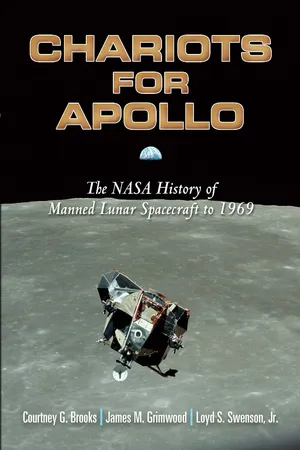
eBook - ePub
Chariots for Apollo
The NASA History of Manned Lunar Spacecraft to 1969
- 576 pages
- English
- ePUB (mobile friendly)
- Available on iOS & Android
eBook - ePub
Chariots for Apollo
The NASA History of Manned Lunar Spacecraft to 1969
About this book
Millions around the world watched as the Apollo 11 astronauts "came in peace for all mankind" to take humanity's first steps on the moon. Their mission's triumph was equally attributable to a less visible crew of nearly 400,000 people in hundreds of different organizations. This official NASA history reveals the human story behind an epic achievement. Written by a trio of experts, it chronicles the engineering and management contributions to the success of Project Apollo, starting with the creation of NASA itself and tracing the design and development of the project's spacecraft and lunar vehicles as well as their operation in space.
Refreshingly free of jargon and technical language, this accessible account focuses on the coordination of efforts behind the production of the Apollo service, command, and lunar modules. It covers three phases of spacecraft evolution: defining and designing the necessary vehicles; developing and qualifying them for the task; and operating them to achieve their objectives. The authors conducted numerous interviews with the project's participants and relied heavily on NASA's extensive archives. In addition to several appendixes, the text is supplemented with more than 100 photographs and illustrations that recapture the efforts of the dedicated team of thousands who reached for the moon.
Refreshingly free of jargon and technical language, this accessible account focuses on the coordination of efforts behind the production of the Apollo service, command, and lunar modules. It covers three phases of spacecraft evolution: defining and designing the necessary vehicles; developing and qualifying them for the task; and operating them to achieve their objectives. The authors conducted numerous interviews with the project's participants and relied heavily on NASA's extensive archives. In addition to several appendixes, the text is supplemented with more than 100 photographs and illustrations that recapture the efforts of the dedicated team of thousands who reached for the moon.
Frequently asked questions
Yes, you can cancel anytime from the Subscription tab in your account settings on the Perlego website. Your subscription will stay active until the end of your current billing period. Learn how to cancel your subscription.
No, books cannot be downloaded as external files, such as PDFs, for use outside of Perlego. However, you can download books within the Perlego app for offline reading on mobile or tablet. Learn more here.
Perlego offers two plans: Essential and Complete
- Essential is ideal for learners and professionals who enjoy exploring a wide range of subjects. Access the Essential Library with 800,000+ trusted titles and best-sellers across business, personal growth, and the humanities. Includes unlimited reading time and Standard Read Aloud voice.
- Complete: Perfect for advanced learners and researchers needing full, unrestricted access. Unlock 1.4M+ books across hundreds of subjects, including academic and specialized titles. The Complete Plan also includes advanced features like Premium Read Aloud and Research Assistant.
We are an online textbook subscription service, where you can get access to an entire online library for less than the price of a single book per month. With over 1 million books across 1000+ topics, we’ve got you covered! Learn more here.
Look out for the read-aloud symbol on your next book to see if you can listen to it. The read-aloud tool reads text aloud for you, highlighting the text as it is being read. You can pause it, speed it up and slow it down. Learn more here.
Yes! You can use the Perlego app on both iOS or Android devices to read anytime, anywhere — even offline. Perfect for commutes or when you’re on the go.
Please note we cannot support devices running on iOS 13 and Android 7 or earlier. Learn more about using the app.
Please note we cannot support devices running on iOS 13 and Android 7 or earlier. Learn more about using the app.
Yes, you can access Chariots for Apollo by Courtney G. Brooks,James M. Grimwood,Loyd S. Swenson, James M. Grimwood, Loyd S. Swenson in PDF and/or ePUB format, as well as other popular books in Physical Sciences & Astronomy & Astrophysics. We have over one million books available in our catalogue for you to explore.
Information
1
Concept to Challenge
1957 to Mid-1961
The orbiting of Sputnik I in October 1957 stirred the imagination and fears of the world as had no new demonstration of physics in action since the dropping of the atomic bomb. In the United States the effect was amplified by realization that the first artificial satellite was Russian, not American. Yet the few scientists and engineers working in Project Vanguard and other U.S. space projects were surprised only at the actual timing. Indeed, they had already considered means of sending man around the moon.
Modern rocket technology dates from the Second World War; the development of intercontinental ballistic missiles in succeeding years resulted in machines that could eventually launch vehicles on space missions. In this same time, man’s flying higher, faster, and farther than ever before suggested that he could survive even in space. Sputnik I caused alarm throughout the United States and the ensuing public clamor demanded a response to the challenge.1 During the next year, many persons in government, industry, and academic institutions studied means and presented proposals for a national space program beyond military needs. After decades of science fiction, man himself, as well as his imagination, moved toward an active role in space exploration.
Concurrently with the formation of the National Aeronautics and Space Administration (NASA) in late 1958—a year after the first Sputnik2—a proposal (which became Project Mercury) was approved to fly man in near-earth orbit.3

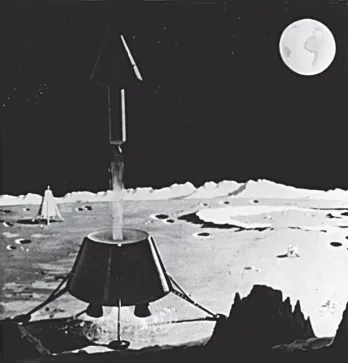
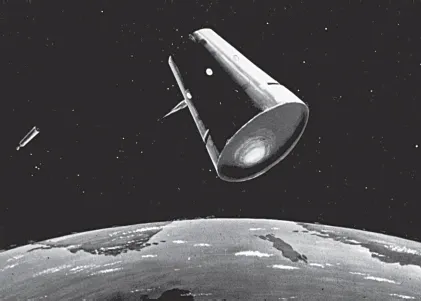
Artist’s concepts sketched about February 1959 were used in a presentation by M. W. Rosen and F. C. Schwenk at the Tenth International Astronautical Congress in London, 31 August 1959. Above, astronauts leave the spacecraft to investigate the lunar surface. At right, the return vehicle takes off from the moon; below, the reentry vehicle begins to enter the atmosphere after jettisoning the propulsion unit.
The National Aeronautics and Space Act of 1958, passed by Congress in July of that year, said nothing about the moon or manned space flight. In its declaration of policy and purpose, however, the general objectives were to improve and use aeronautical and space capabilities “for the benefit of all mankind.” If achieving international leadership in space meant that this nation would have to fly men to the moon, the Act encouraged that ambition.4 Clearly NASA, as the nonmilitary agency of the United States, would be responsible for furthering the national interest in space affairs. But the new agency required more than just a charter before the President and the Congress could turn it loose on a task requiring a vast acceleration of activity and a large commitment of national resources.
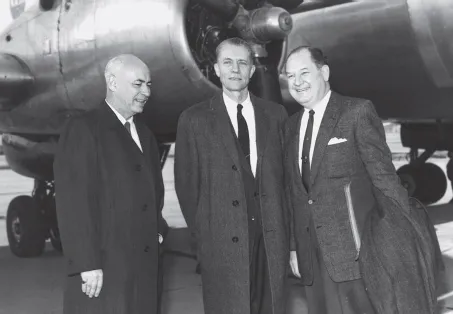
Space Task Group Director Robert R. Gilruih, left, and Langley Research Director Floyd L. Thompson, center, welcome NASA Administrator T. Keith Glennan to Langley Field, Virginia, for a January 1961 tour.
Much of the preliminary planning for Project Mercury had been done by the National Advisory Committee for Aeronautics (NACA), NASA’s predecessor. NASA’s first Administrator, T. Keith Glennan, president of Case Institute of Technology (on leave), set about organizing and using the heritage of experience and resources that had carried Mercury from the planning stage into actuality. His deputy, Hugh L. Dryden (former Director of NACA), planned and executed policy decisions during NASA’s first few years. Abe Silverstein, who came from NACA’s Lewis Flight Propulsion Laboratory in Cleveland, was assigned by Glennan to manage a coordinated program for a stable of rocket boosters to suit a variety of space missions.5
The White House had approved plans to develop big boosters, but Glennan knew that would not be enough. He wanted organizations that had participated in developing these vehicles, and toward this end he laid plans for the eventual transfer of the California Institute of Technology’s Jet Propulsion Laboratory (JPL) and of the Army’s Wernher von Braun team (Army Ballistic Missile Agency; ABMA) into the NASA family. In January 1959, Wesley L. Hjornevik, Glennan’s assistant, pressed the Administrator to “move in on ABMA in the strongest possible way . . . because it is becoming increasingly clear that we will soon desperately need this or an equivalent competence.” Although JPL came into the fold soon after the agency opened for business, a year and a half passed before Glennan persuaded the Eisenhower administration to consign a portion of ABMA and some of its facilities, later named the George C. Marshall Space Flight Center, to NASA.6
In addition to the oldest NACA laboratory—at Langley Field, Virginia, across Hampton Roads from Norfolk—and the other two NACA laboratories—Ames, at the lower end of San Francisco Bay, and Lewis, in Cleveland—NASA inherited the NACA authorization to build a center for development and operations. Dryden was well aware of the applied research character of Langley, Ames, and Lewis. He was anxious to insulate these former NACA centers from the drastic changes that would come while shifting to actual development in NASA’s mission-oriented engineering. Space science, mission operations, and, particularly, manned space flight should, he thought, be centralized in the new facility to be built near Greenbelt, Maryland. To direct Project Mercury, Glennan established the Space Task Group, a semiautonomous field element under Robert R. Gilruth. When the new center was completed, the Mercury team would move to Maryland.* In May 1959, Glennan announced that this new installation would be called the Goddard Space Flight Center in commemoration of Robert H. Goddard, the American rocket pioneer.7
Besides the NACA personnel, programs, and facilities, NASA acquired, by transfer, ongoing projects from the Army (Explorer), Navy (Vanguard), and Air Force (F-1 engine).8 These were worthwhile additions to the new agency; to comply with the language and intent of the Space Act, however, NASA had to plan a long-range program that would ensure this country’s preeminence in space exploration and applications.
THE STARTING
As part of its legacy NASA inherited the insight of an ad hoc Space Technology Committee into what some of its research goals should be. At the behest of James H. Doolittle, Chairman of NACA’s Main Committee, in February 1958 H. Guyford Stever of the Massachusetts Institute of Technology had headed a group that examined a wide variety of possible space projects, giving NACA needed guidance for research into space technology. Exploration of the solar system was seen as an arena where man, as opposed to mere machines, would definitely be needed. When NASA opened for business in October 1958, this recommendation in the Stever Committee’s final report gave the new agency a start on its basic plans.9
Sending men beyond the earth’s gravitational field, however, required launch vehicles with weight-lifting capabilities far beyond that of the Atlas, the only American missile that could lift the small Mercury spacecraft into earth orbit. Moreover, there was nothing being developed and very little on the drawing boards that could carry out the Stever Committee’s suggestion. Glennan was therefore willing to listen to anyone who might provide a sensible booster development plan. On 15 December 1958, he and his staff sat in their headquarters in the Dolley Madison House in Washington to be briefed by missile development leaders from ABMA. Wernher von Braun and two associates, Ernst Stuhlinger and Heinz H. Koelle, surveyed the capabilities of current and planned boosters, their utility for various space missions, and ABMA’s work on launch vehicle design and operation. In essence, they described how their agency might play a leading role in America’s national space program.10
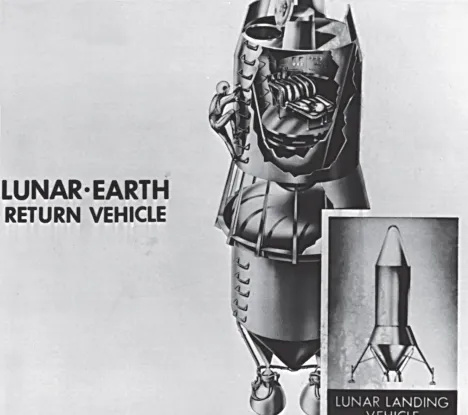
A lunar—earth return vehicle as envisioned at the Army Ballistic Missile Agency in early 1960 was drawn for Wernher von Braun’s use in an ABM A study, “A Lunar Exploration Program Based upon Saturn-Boosted Systems.”
The theme of these presentations was manned landings on the moon. Koelle emphasized the need for a few versatile space vehicles, rather than a plethora of different models. ABMA offered a program for building a family of these rockets. Koelle predicted that perhaps by the spring of 1967 “we will have developed a capability of putting . . . man on the moon. And we still hope not to have Russian Customs there.” He stressed how neatly ABMA’s launch vehicle program complemented NASA’s emerging manned space flight activity. “The man-in-space effort,” he said “dovetails with the lunar and cislunar activities because you simply can’t land a man on the moon before you have established a man-in-space capability; that is quite clear.”11
Von Braun said ABMA preferred clustering engines in launch vehicles, emphasizing that the multiengine concept of aviation was directly applicable to rockets. Next he talked about plans for a multistage Juno V—suggesting different propellants for particular stages—the most ambitious rocket ABMA then contemplated.
To answer, “What will it take to get people to the surface of the moon and back?” von Braun described five techniques, direct ascent and four kinds of rendezvous en route. Assuming the feasibility of high-energy (liquid-hydrogen and liquid-oxygen) upper stages and a capsule conservatively estimated at 6170 kilograms, for direct ascent “you would need a seven-stage vehicle which weighed no less than 13.5 million pounds [6.1 million kilograms].” Developing and flying such a rocket was forbidding to von Braun.
Instead of this enormous vehicle, he suggested launching a number of smaller rockets to rendezvous in earth orbit. He proposed using 15 of these, which “it just so happens,” he said, wryly, “had the size and weight of the Juno V.” These boosters could place sufficient payload in orbit to assemble a vehicle of some 200 000 kilograms, which could then depart for the moon. The lunar-bound craft would be staged on the way, dropping off used tanks and engines as the flight progressed—“in other words, leave some junk behind.”12
Next, Stuhlinger rose and said:
The main objective in outer space, of course, should be man in space; and not only man as a survivor in space, but man as an active scientist, a man who can explore out in space all those things which we cannot explore from Earth.
He catalogued the unknowns of space vehicle components and research objectives in materials and in protection against space hazards. What happens, for instance, to metals, plastics, sealants, insulators, lubricants, moving parts, flexible parts, surfaces, coatings, and liquids in outer space? How could we guard men and materials from the dangers of radiation, meteorites, extreme temperatures, corrosion possibilities, and weightlessness? What kinds of test objectives, in what order and how soon, should be established? “We . . . are of the opinion that if we fail to come up with answers and solutions to [these] problems, then our entire space program may come to a dead end, even though we may have the vehicles to carry our payloads aloft.”13 Although Glennan was impressed, he knew that NASA’s first tasks were Mercury and the giant F-1 rocket engine.
Congress had been seeking some consensus of what the nation should do in space. At the beginning of 1959, the House Select Committee on Astronautics and Space Exploration released a staff study, The Next Ten Years in Space, reporting a poll of the aerospace community on the direction of America’s space program through the 1960s. Prominent among projected manned programs beyond Mercury was circumlunar flight. Those queried spoke confidently of this goal, saying it was only a question of time. Not a single spokesman doubted the technical feasibility of flying around the moon. Predictions spanned the latter half of the decade, with expectations that manned lunar landings would follow several years later.14
Glennan and Dryden, responding to congressional inquiry, subscribed to this belief. They outlined NASA’s plans in space sciences, the application of space capabilities to the national welfare, and research and development in advanced space technology. “There is no doubt that the Nation has the technological capability to undertake such a program successfully,” they said. “There is a good chance that [within ten years] space scientists may have circumnavigated the Moon without landing and an active program should be underway to attempt a similar flight to Venus or Mars. . . . Manned surface exploration will be receiving serious research and development effort.”15
The NASA Administrator immediately asked for funds to begin designing and developing a large booster, the first requirement for space exploration. At the end of January 1959, NASA submitted to President Dwight D. Eisenhower a report on “A National Space Vehicle Program,” in which the agency proposed four boosters, Vega, Centaur, Saturn, and Nova.*
These rockets were expected to fulfill all foreseeable needs during the next decade. Although Vega and Nova barely progressed beyond the drawing boar...
Table of contents
- Cover
- Title Page
- Copyright Page
- Contents
- Introduction to the Dover Edition
- Foreword
- Preface
- 1. Concept to Challenge
- 2. Project Planning and Contracting
- 3. Contending Modes
- 4. Matching Modules and Missions
- 5. Command Module and Program Changes
- 6. Lunar Module
- 7. Searching for Order
- 8. Moving toward Operations
- 9. Tragedy and Recovery
- 10. Race with the Decade
- 11. Tastes of Triumph
- 12. The Trailblazers
- 13. To Land on the Moon
- 14. Trip to Tranquility
- Epilogue
- Appendix A. Manned Spacecraft Center Site Selection Procedure
- Appendix B. Astronaut Assignments
- Appendix C. Apollo Flight Program
- Appendix D. Apollo 11 Experiments
- Appendix E. Apollo 11 Lunar Samples
- Appendix F. Major Spacecraft Component Manufacturers
- Appendix G. Apollo Program Responsibilities of the Manned Space Centers
- Appendix H. Funding—as of 30 june 1969
- Source Notes
- Bibliographical Note
- Index
- List of NASA Photograph Numbers